Khalkin-Gol
Behind an almost unknown Red Army victory stood an American tank designer
ON AUGUST 22, 1939, an event occurred in a little known, untraveled and out-of-the-way place in the world that changed the history of the globe. Had its lessons been learned, had the specialists in the field possessed the necessary intelligence to grasp its significance, the political map of the planet would be entirely different. It was the day of Khalkin-Gol.
To understand this battle at the Khalkin-Gol river in Mongolia, the observer must flash back to the United States in the spring of 1919, when a mechanic in New Jersey named Walter Christie appeared with a revolutionary tank design, of vastly increased mobility, recognized at the time by the young Army officer, George S. Patton, as the world’s best tank. Nevertheless, Ordnance Corps representatives reviewed the Christie tank and rejected it as being “too difficult to maneuver,” a fact which threatened Christie with bankruptcy and the loss to the wealthy Patton of the loans he had made to Christie’s company. However, certain shrewd foreign eyes were aware of the epochal nature of Christie’s invention. In 1920 agents of the newly created Soviet Union saved Christie from bankruptcy by buying his tank.
The Christie tank became the backbone of the Soviet Red Army in the 1930s. Meanwhile, appropriations for tank development in the American Army had been voted down by Congress, as its members had talked about “the economic impossibility of building enough tanks to constitute a mechanical army.” It was thus obvious that political and military figures in the U. S. saw little future in the tank. In 1939 the Soviet engineers had produced an advanced development of the original Christie tank and the Kremlin had trained and fielded the world’s largest army for its deployment in future battles. The significance of its continued development and deployment was not understood clearly by the military and political leaders of other nations. Neither was the potential capacity by the Soviets to produce 102,000 of them during World War II. The dire import of Soviet tank preparations and manufacturing capacity was either unknown, misunderstood, or ignored in precisely the two countries where it was most important to know and understand such things — Japan and Germany. It was not realized that the tractor factories established by the Communist dictatorship in Russia had a dual purpose: (1) to make the collective-farm system possible (and thus keep the Communists in absolute control of the Russian peasantry); and (2) to be readily convertible to the production of tanks, which would repel foreign invaders.
Different Tactics
In 1939 Japan was politically dominated by the Japanese Army, the senior service, a distinctly less technically inclined armed force than the Japanese Navy. The Army bore deeply within its innermost soul certain profound medieval convictions, proved, its officers believed, since time immemorial in the crucible of battle. The undying spirit of Yamato Damashii, Bushido, the Way of the Warrior, the Code of the Samurai, the Spirit of Old Japan — who could withstand this nation of superhuman, inspired fighters? The Supreme emphasis in the Japanese Army was on the spiritual aspect of human combat. Valor, elan, dedication — these were the mystic keys to victory, and the warrior lived like the cherry blossom, a short-but-sweet existence and a glorious death. In 1905 had not the swordsmen and riflemen of the Samurai swept the land and sea of the Russians? Of course, attention would be paid to modern equipment and tactics, but Spirit would… always be the deciding factor. Few Japanese seemed to realize that in the 1930s they had been fighting tankless Chinese land armies.
The Communists, the new ruling class of the former Russian Empire, took a fundamentally different view of what made for success in war. Although a vigorous, if not too successful, propaganda campaign was conducted to instill revolutionary fervor in drafted recruits, the Party’s primary emphasis was on modernizing the Russian Army, above all with masses of continuously developed and improved tanks of the newest design. Communist military incentive would be instilled by the commissar system, NKVD battalions, and “obstacle” regiments to discourage undesirable retreats. Aircraft development with the primary purpose of tank support was pressed. For artillery backup of armored vehicular formations, the Communists had at their disposal the formidable Russian artillery tradition.
In 1812 Russian artillery had been technically equal (if not in deployment) to Napoleon’s, which was the best in Europe. Much earlier, had not Russian engineers designed the Turkish guns that had battered down the walls of Constantinople in 1453? Had not artillery been the weapon used by the Russians to get rid of the formerly invincible Mongol cavalry that had once dominated their country? Not only did the Soviet tanks become larger, faster, and with heavier armor than those of any other nation — they soon mounted guns of bigger caliber. Paratroops were introduced as early as the 1920s. And, generally ignored by the world’s press, an effective, incessant practice to bring the newly coordinated ground forces to tactical perfection was conducted and pressed by the Communist Party, which had uniquely blended its political role with the military.
Undeclared War
By May 1939 the Japanese Army had spent a year of probing the Soviet Mongolian border from its bases in the newly established Japanese puppet state of Manchukuo, formerly Chinese Manchuria. The attacks began first at patrol level, then moved to platoon and company strength, their victims being primarily small border units of the Soviet Mongolian People’s Democratic Republic, a picturesque name devised for part of Red-dominated central Asia. Presently the Japanese forces crossed the Mongolian border in regimental numbers. Field Marshal Vassily Blucher (real name unknown), later liquidated in a Stalinist purge, appeared with some Soviet armored groups and, in small skirmishes that were highly humiliating to the Japanese, hurled them back over the Amur River at Chang-ku-feng. Thirsting for revenge, the Japanese gradually moved up heavier forces.
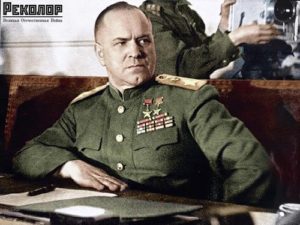
In June 1939 General G. K. Zhukov was dispatched to Mongolia by the Kremlin. Information had been received that a major Japanese military force, the entire 6th Army, had entered Soviet Mongolia, routed Mongolian forces and taken up positions east of the Khalkin-Gol river. After reporting to Moscow that local forces were inadequate to handle the Japanese, Zhukov called for three Soviet motorized infantry divisions with tank units, an armored division, massive artillery reinforcements and carefully selected squadrons of Russian airmen were requested. Meanwhile, Soviet reconnaissance, conducted under cover of aerial dogfights from June 22 to July 1, 1939, revealed the startling presence of a major Japanese military force in Soviet Mongolia, whose mission appeared to be the seizure of a bridgehead west of the Khalkin-Gol to provide a springboard for the conquest of Mongolia. So sure were the Japanese of imminent victory that foreign correspondents and military attaches of foreign embassies were invited to view the projected rout of the newly arrived Russians. On July 3, 1939, the Japanese, in an initial aggressive move, attacked and routed a Mongolian cavalry division, which retreated behind the Bain-Tsagan mountains.
The Soviets, using every known trick of detection and camouflage, then moved stealthily into place an awesome series of armored and motorized infantry divisions, as well as another Mongolian cavalry division, and deployed fresh aircraft reinforcements. And the Japanese? How men cling to outworn ideas! On the morrow the invincible Samurai would advance with a great cry, “A-a-a-arach!” and sweep the stodgy whites from the field.
Annihilation
On the slopes of Bain-Tsagan the Japanese concentrated 10,000 shock troops, 100 guns and 60 antitank pieces. It was on this day, July 3, that an artillery barrage of a magnitude never experienced by a Japanese army drenched the Nipponese advance troops who had crossed the river and occupied the mountain. After two days of massive saturation, some half-crazed survivors bolted back over the river, having never once seen the enemy on foot. They spoke wildly of being surrounded by “ghastly” numbers of huge tanks, of being gunned down and blasted by low-flying aircraft supporting the tremendous tank attacks and artillery barrages.

Ten thousand men, almost the entire force, had been annihilated. The frenzied Japanese counterattacks had merely accelerated the carnage. The Commander of the Japanese 6th Army, Kamatsubara, thought at this critical moment that the worst had finished. It had not; arriving from the Soviet Trans-Baikal Military District came two more Russian motorized infantry divisions, another tank brigade, two artillery regiments and “other formations.” More bomber and fighter wings arrived, yet the Japanese, unaware of these movements, were now certain it was over; the Soviets gave no indication of planning another offensive. This was, of course, precisely when the intensive preparation for the destruction of the remainder of the Japanese 6th Army was instituted. On August 20, 1939, the general officers of the 6th Army, confident that the six-week lull in Soviet activity would continue, waited for reinforcements. Some had even taken leave to various Manchurian cities. At dawn, on an early Sunday morning, a month after the Bain-Tsagan extermination of the forward elements of the Japanese, the Khalkin-Gol area erupted in a deafening roar of massed artillery, grinding tanks, and aerial bombing. Heavy Soviet armored formations, their existence undreamed of by the Japanese, struck with lightning-like rapidity around their flanks and surrounded them. The hand-picked Japanese regiments fought with maniacal fury, but their antitank guns scarcely knocked the paint off the heavy steel sides of the Christie-descended Russian tanks. It was all over by August 22. The Japanese 6th Army died to a man — something on the order of 19,000 men, as the Tokyo government admitted, although other estimates put the toll much higher. Two days after Khalkin-Gol, although it was a splendid victory for Communist Russia, Stalin, who feared above all the possibility of a two-front war, signed the 1939 Ribbentrop Non-Aggression Treaty with Nazi Germany. The Japanese, he felt, he could handle. The Germans and the Japanese were a different proposition.
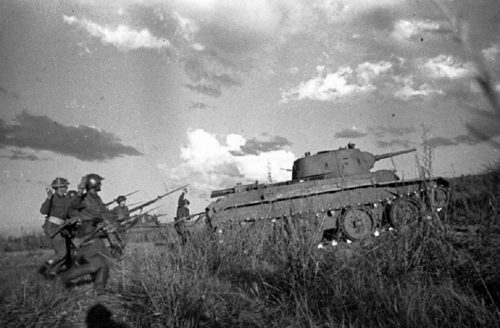
Fallout
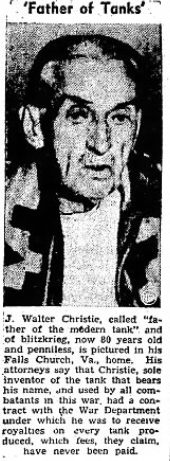
The significance of the Khalkin-Gol encirclement of the Imperial Japanese 6th Army was either unknown to, or ignored by, the general staffs of Germany, France, Great Britain, and the United States. Two years later, the Germans, with one-fourth the population of the Soviet Union and but six years of military preparation, attacked the heavily armed Soviet colossus on a 1500-mile front. The British and American general staffs predicted that the Germans would conquer Russia in six weeks, even though it would take longer than that for the German Army to move across the Soviet Union without fighting anybody. Thus the real wonder and marvel of the Russo-German War of 1941-45 was not the Russian resistance, but that the Germans were able to break into Russia at all.
As for the Japanese political and military leadership, its lack of reasoning power continued. At the moment when all Asian-based Soviet armor was necessarily being drained into European Russia to prevent the imminent collapse of the Kremlin’s armies in the West, the Japanese struck. At the conquerors of the 6th Army? No — they thought this was too dangerous — they had enough of Walt Christie’s tank. They decided, on the basis of Khalkin-Gol, to hurl their forces at the United States, a power three times stronger industrially than the Soviet Union, potentially capable of not merely destroying a Japanese army but Japan itself.
What may the nonprofessional observer of politico-military matters deduce from Khalkin-Gol? First and foremost it is evident that military efficiency is indivisible from politics. The difference between the Russian Army of 1905 and that of 1939 was the Communist Party, which ruthlessly built the heavy industry that would supply the tanks and trained the army that would use them. Had it not been for this political factor, the Russian military command would have advanced into battle with the same preconceived notions reflected by the French, British, Japanese, and Americans. The signal from Khalkin-Gol to Germany was caution in view of the preparations carried on by the Communists in a country with four times larger a population than Germany and incomparably more resources. The signal to Japan was that only a close liaison with Germany and an extreme national effort could achieve the defeat of the Soviet giant. Neither was received.
* * *
Source: Instauration magazine, February 1977


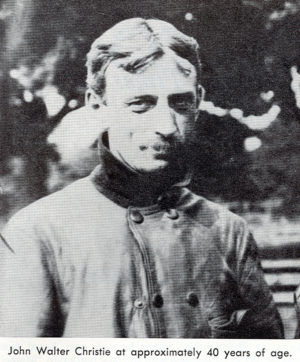

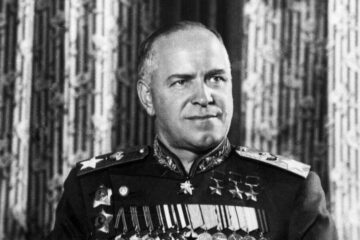

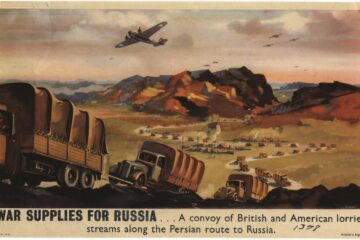
This is a very curious news to that eternal war.
It explains why earlier American tank designs resemble the CHristie tank, the T-34.
It is also interesting and suspicious that the Wehrmacht never engaged the T-34 until October of 1941. They were impressed. Even though they had the captured blue print high command would dismiss the urges of Heinz Guderian to emulate Christie’s design.
The T-34 was not excelled by German design until summer of 1943. But the prototypes were hastily used and were not ready.
They would lose the critical battle of Kursk and Orel.
It may further explain why many T-34 would be made in AMerica and shipped with other crucial war material to Russia.
The T34 was NOT “made in AMerica”:.Not ever. Not even one.
Most Soviet tanks with Christie suspensions were light tanks, destroyed in vast numbers by the Germans, before the Soviets dropped light tank production altogether (mostly in favor of the Su-76 self-propelled gun).
The Christies suspension used too much internal space, and was dropped post-WWII by everyone. The Soviets considered replacing it in the T34, iirc, but didn’t think it was worth retooling their production lines to do it.
That Patton invested in Christie’s company is news to me. Sounds corrupt, if true, but I wouldn’t take this author’s word for it..